Introduction
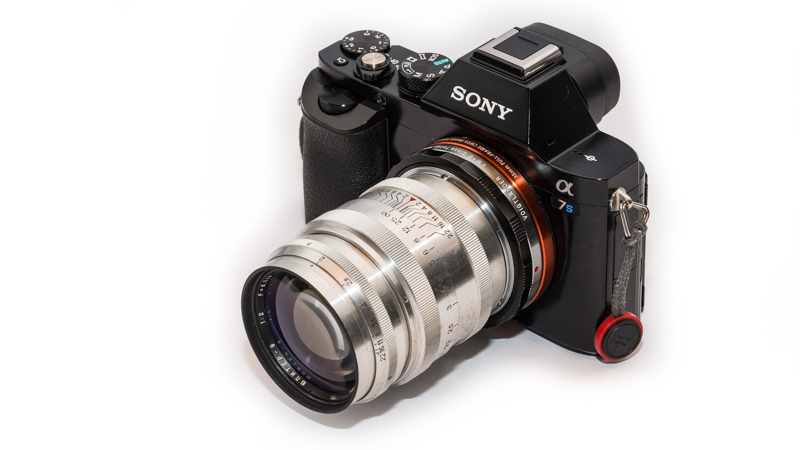
The Jupiter-9 85mm 2.0 is actually a copy of the Zeiss Sonnar 85mm 2.0 and was produced in the UDSSR after WWII. This is my favourite among the Jupiter lenses tested so far, read on to find out why!
Sample Images
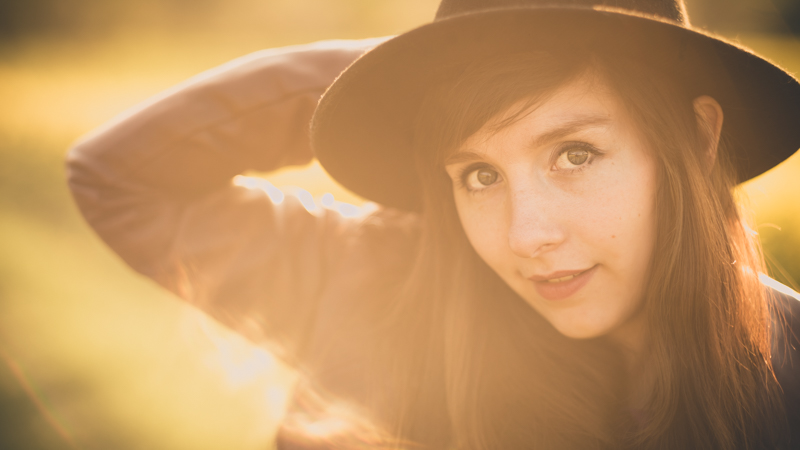
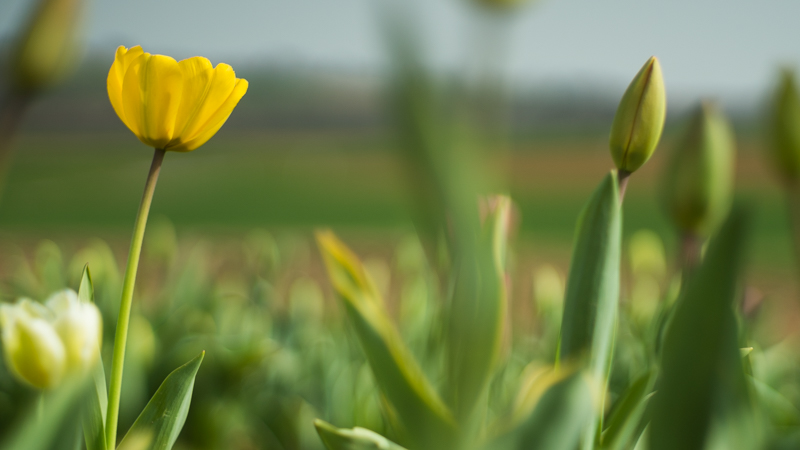
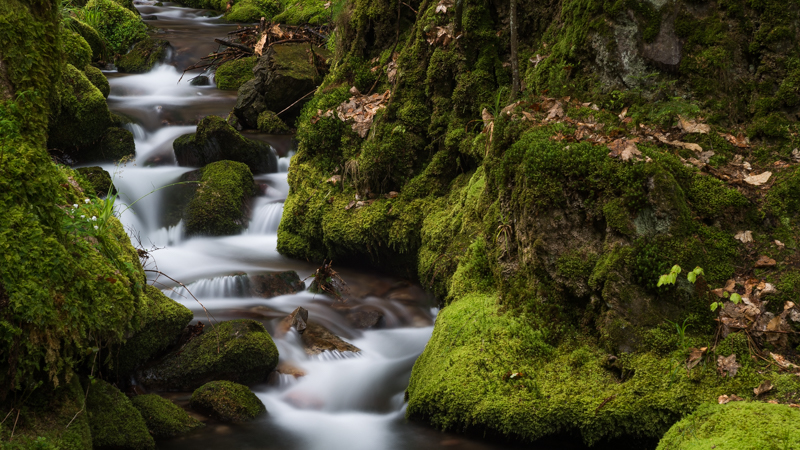
Specifications / Version History
The outer apperance of the lens has changed over time and regarding the optics early versions may actually use Zeiss glass produced in Germany and some later ones may have different coatings as well. So in case you are curious, take a look at the page sovietcams.com, for additional coverage.
I am reviewing a quite early lens from 1958 here (the first two digits of the serial number are the production year, 58 in this case) which has the following specifications:
-
- Diameter: 58.0 mm
- Field of view: 29° (diagonally)
- Length: 76.0 mm
- Weight: 318 g
- Filter Diameter: 49 mm
- Number of Aperture Blades: 15 (rounded)
- Elements/Groups: 7/3
- Close Focusing Distance: 1.1 m (with Helicoid ~0.7 m)
- Maximum Magnification: 1:11.3 (with Helicoid 1:7.3)
- Mount: M39 (aka LTM or Zorki)
A Jupiter-9 in good condition usually starts selling for $145 at ebay.com (affiliate link). In Germany buying one in A-condition will set you back at least 115€. I got mine at ebay.de
(affiliate link).
Handling / Build Quality
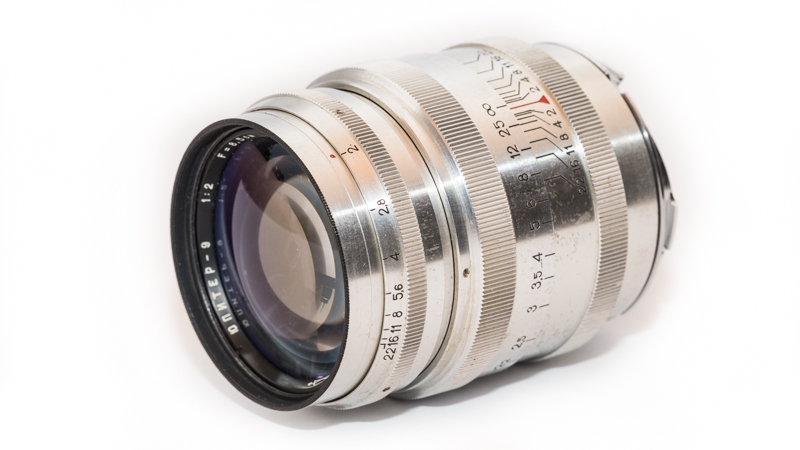
There is quite some sample variation with these lenses. This one had an easy to operate aperture ring but a very stiff focusing ring. You can either try fixing this yourself with the help of some tutorials or videos on the internet or bring it to a repair shop instead. The best idea is of course to buy your lens from a trusted seller. I can recommened this ebay shop (affiliate link) as I have bought lenses there myself.
Turning the focusing ring from infinity to 1.0 m takes about 120°, turning the aperture ring from f/2.0 to f/22 takes about 80°. The aperture ring has no click stops. I prefer click stops but in case you consider filming with this lens you may prefer it the way it is. There is no official hood I know of. Using filters is not a problem as the filter ring doesn’t rotate.
This lens is made from aluminium which contributes to the low weight but is also very good at attracting scratches. Newer versions are still made from aluminum but painted black and don’t attract scratches as much to my experience.
Vignetting and colorcast
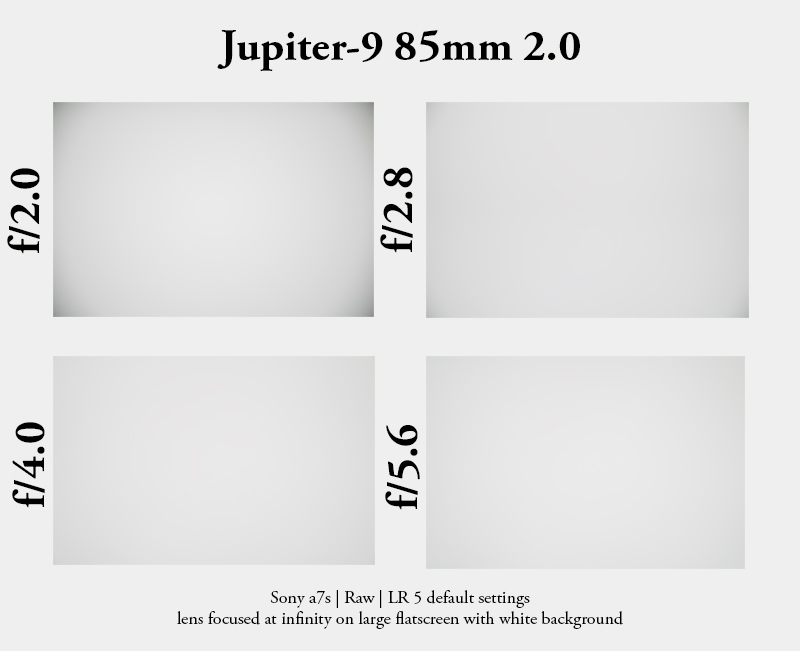
Taking the physical dimensions into account vignetting is suprisingly low at only 1.6 EV wide open and rarely noticeable further stopped down.
Sharpness
infinity

Wide open the lens is somewhat soft and not really contrasty in general. This can be favorable for portraits, for landscape and architecture, not so much. The center looks pretty good af f/2.8, the midframe at f/5.6 and the corners quite ok at f/11.
close focus
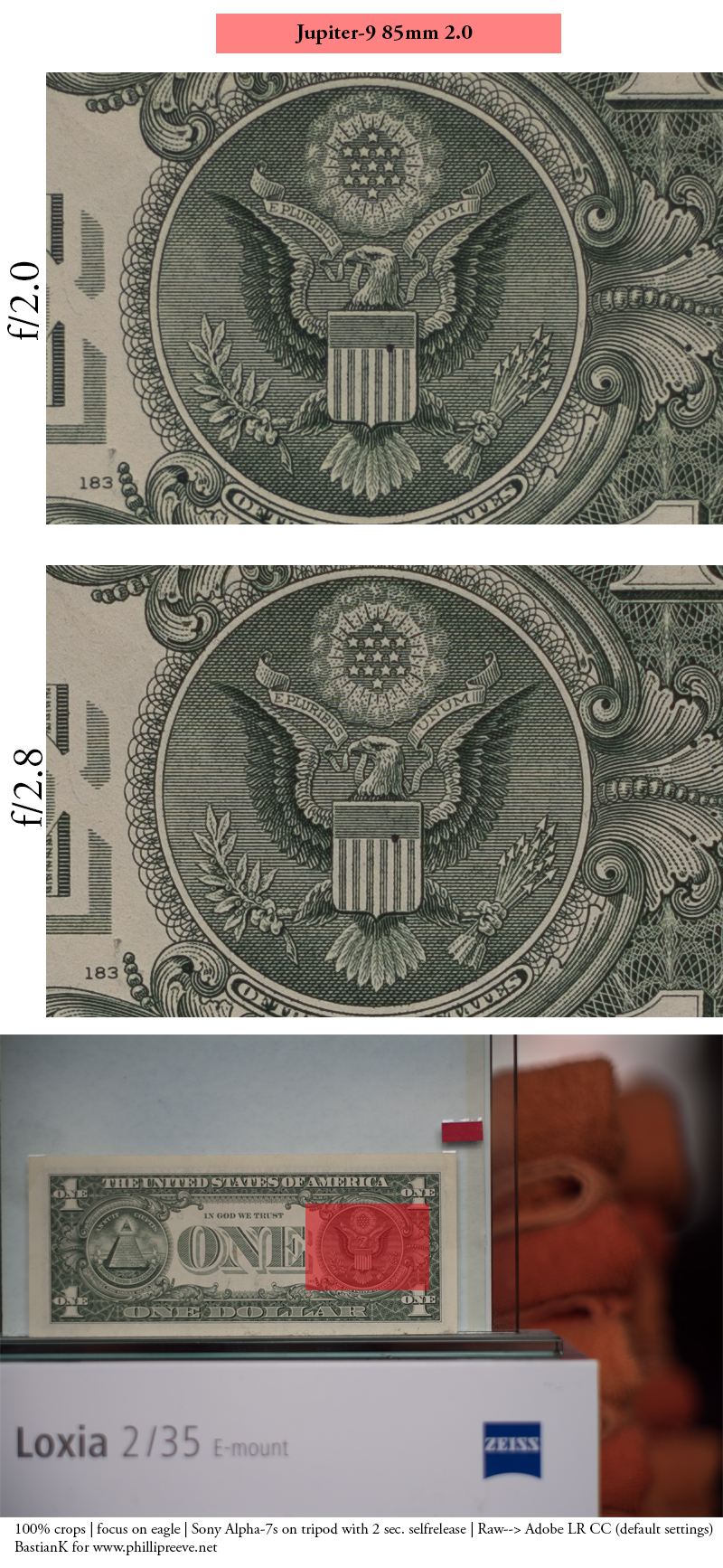
For these shots I was using the VM-E helicoid adapter at maximum extension (around 4 mm), so keep in mind you are looking at 100% crops of photos taken at the extended(!) minimum focus distance. The lens was never intended to be used at these distances and does not incorporate a floating elements design either, still the performance wide open isn’t all that bad. Stop down to f/2.8 and things look very good here.
Flare resistance
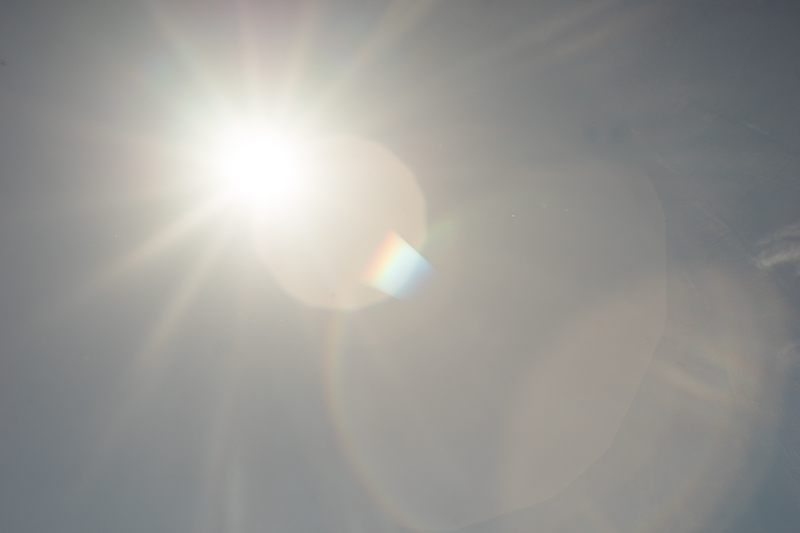
The flare resistance is certainly nothing to write home about and the lens certainly shows it’s age here. You get ghosts, other artifacts and much lower contrast.
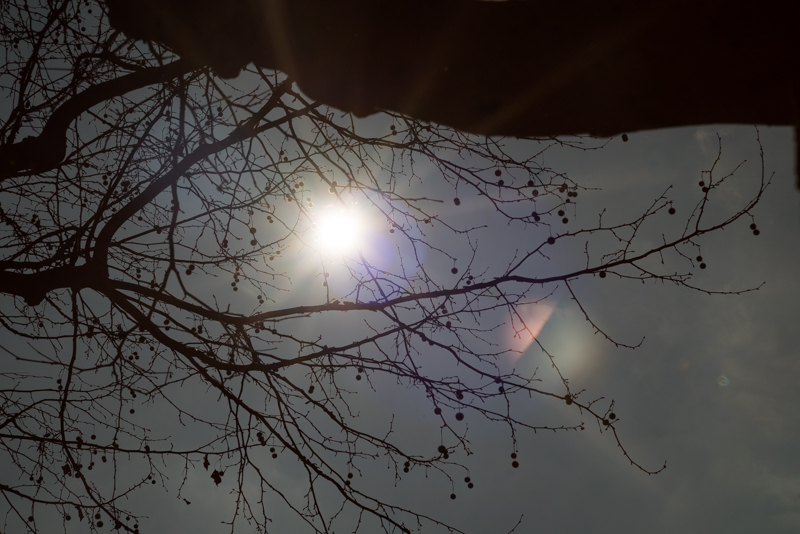
Coma
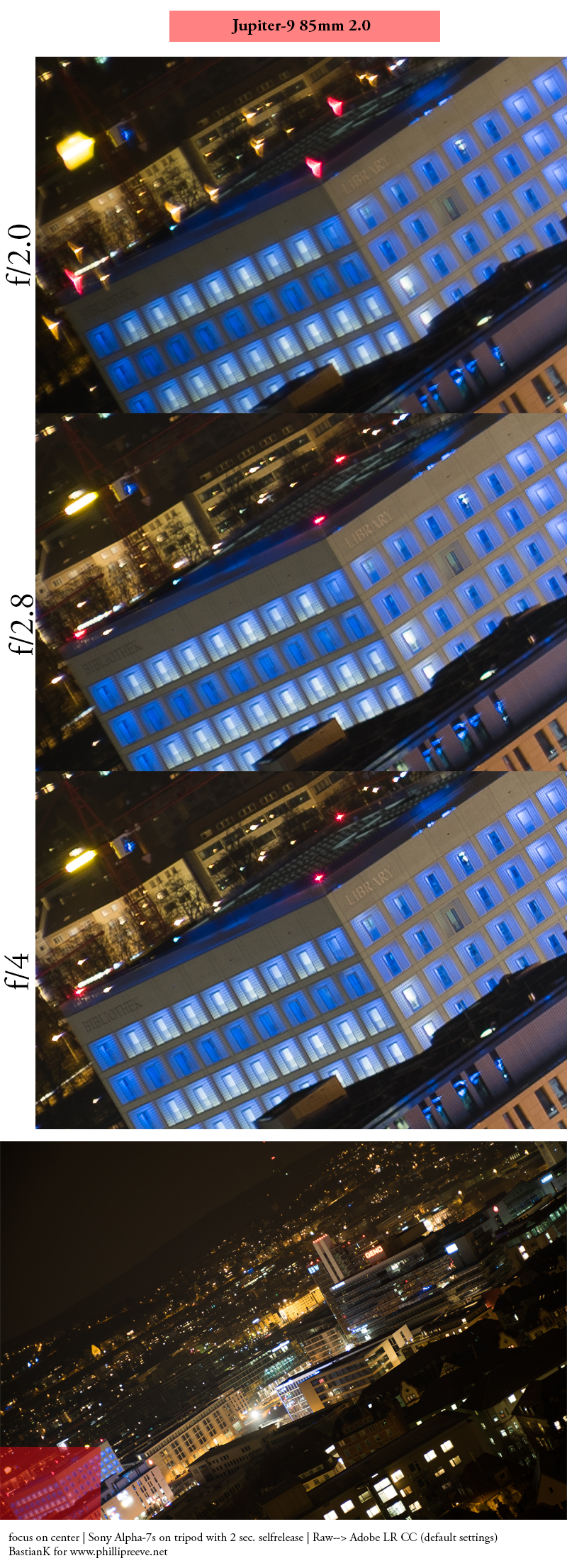
Wide open the performance isn’t great here, stopping down to f/4.0 helps a lot. So stop down to at least f/4.0 when shooting city scapes or similar subjects.
Distortion
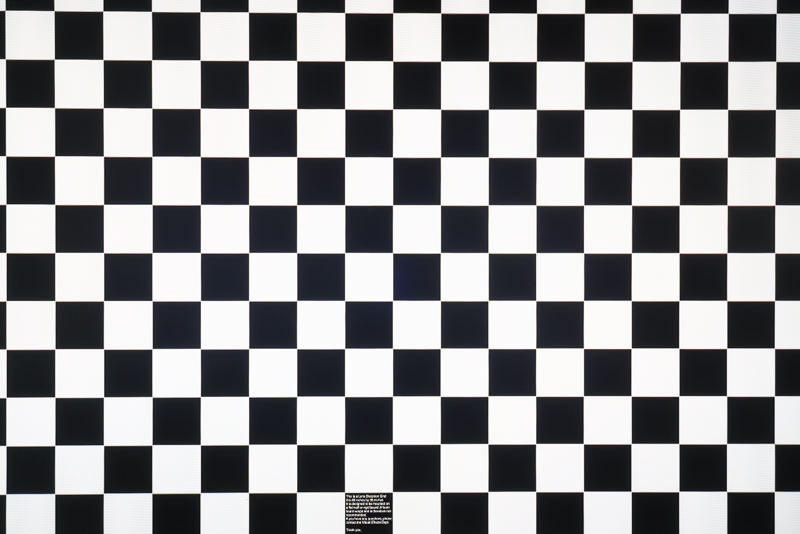
There is very minor pincushion Distortion which I don’t consider an issue.
Bokeh
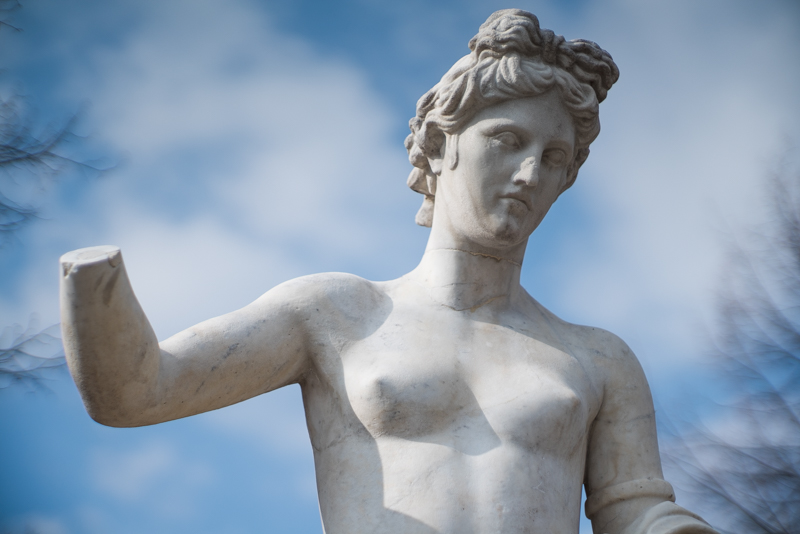
Certainly one of the strong points of the lens, in case you like Sonnar bokeh. The edges get blurred quite a lot as can be seen in the example above. There are no onion rings, hardly any outlining and because of the 15 rounded aperture blades highlights stay nearly perfectly round on stopping down.
Interestingly mechanical vignetting is not really an issue, because of the small dimensions of the lens this really suprised me.

Bokeh, crop of upper right corner, f2.0 (before) / f4.0 (after)
Sunstars
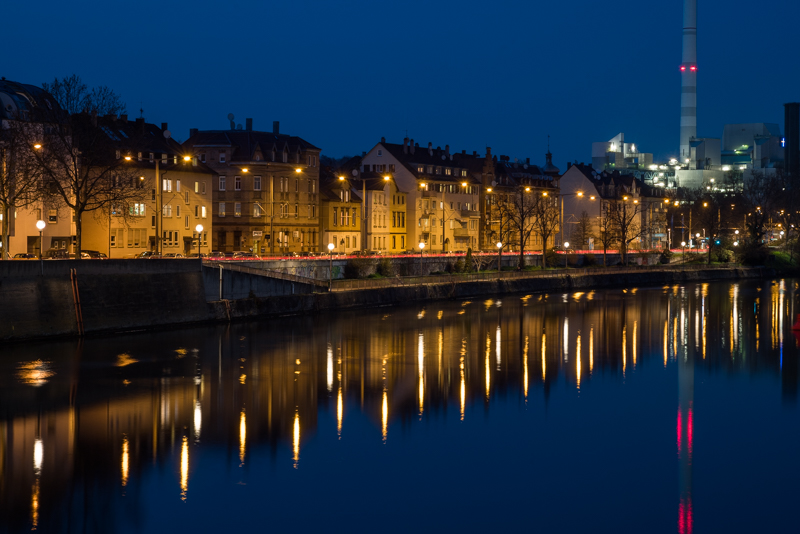
If have written it before, you either have nice highlights on stopping down or nice sunstars and 15 rounded aperture blades lead to pretty bad sunstars:
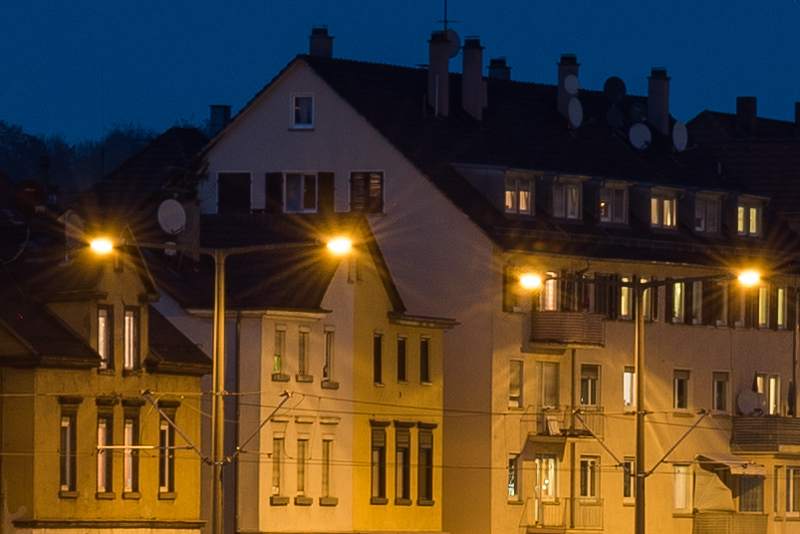
Chromatic aberrations
longitudinal
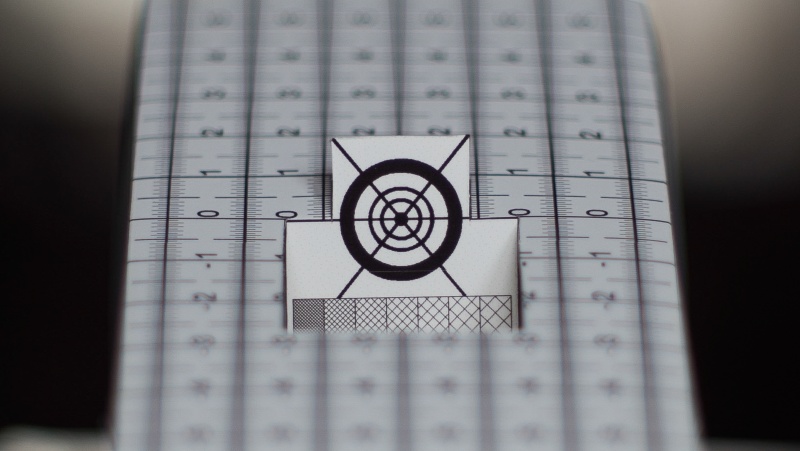
The loCA correction is pretty good for such a fast yet old lens. In real world shooting I did not even once notice loCA in a bothersome way in any of my pictures. Only with the use of the helicoid adapter (which works as a 4 mm extension tube here) at the extended minimum focus distance loCA start to appear.
lateral
In the corners you can spot some lateral CAs which can be easily corrected in post, as can be seen in the example below (100% crop). This is one of the few lenses where the outlinings are yellow and purple instead of magenta and cyan.
Sony A7s | Jupiter-9 85mm 2.0 | f/4.0 | CA 100% crop before/after extreme corner
Alternatives
Leica Summicron-M 90mm 2.0 pre-Asph:
This is still my preferred portrait lens when using A7 cameras. Better optics, way better build quality, about six times as expensive.
Zeiss Batis 85mm 1.8:
In case money isn’t really an issue and you prefer a native lens with AF and IS this lens might be for you. I haven’t used one myself but Jannik is currently using one and preparing a review.
Legacy SLR 85mm lenses:
85mm has always been a popular focal length so there are many legacy lenses to chose from. You can start having a look at this comparison.
Conclusion
good
|
average
|
not good
|
This lens has become quite the classic and I can definetly understand that. The lens is small, lightweight, affordable, offers great bokeh and stopped down sharpness isn’t bad either. Still I see it more as a special purpose lens for portraiture than a general purpose tele. Sharpness and especially contrast aren’t up to my taste for landscape and architecture, neither are the sunstars.
There are also lenses with better handling, as the aperture ring has no click stops you pretty much have to look at the lens when changing the aperture, which is something I don’t like. There also seems to be quite a bit sample variation. I have had two of these lenses so far, one with wobbly aperture ring and stiff focusing ring, the other one quite ok, so only buy from trusted sellers or be sure to try before buy.
So, who is this lens for? Anyone, who looks for a small yet fast and affordable portrait lens and can live with the so so build quality and handling. One thing is for sure: this is the biggest bang for the buck when it comes to rangefinder portrait lenses.
A Jupiter-9 in good condition usually starts selling for $145 at ebay.com (affiliate link). In Germany buying one in A-condition will set you back at least 115€. I got mine at ebay.de
(affiliate link).
Sample Images
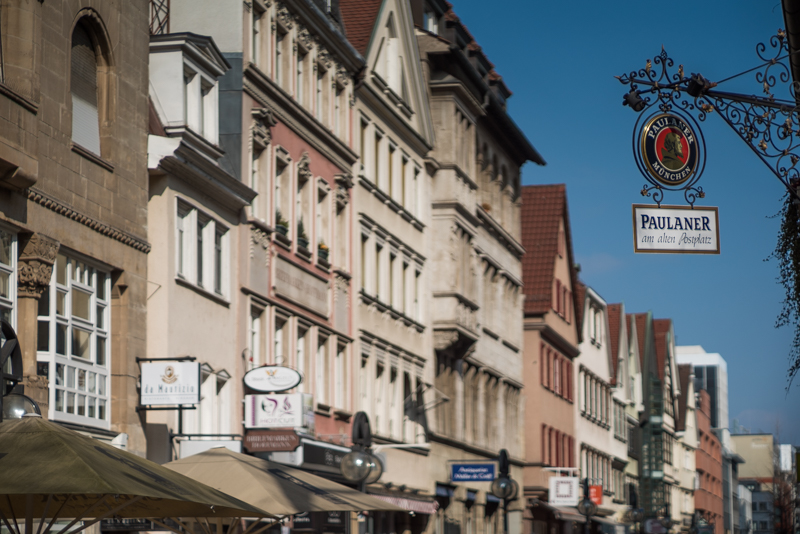
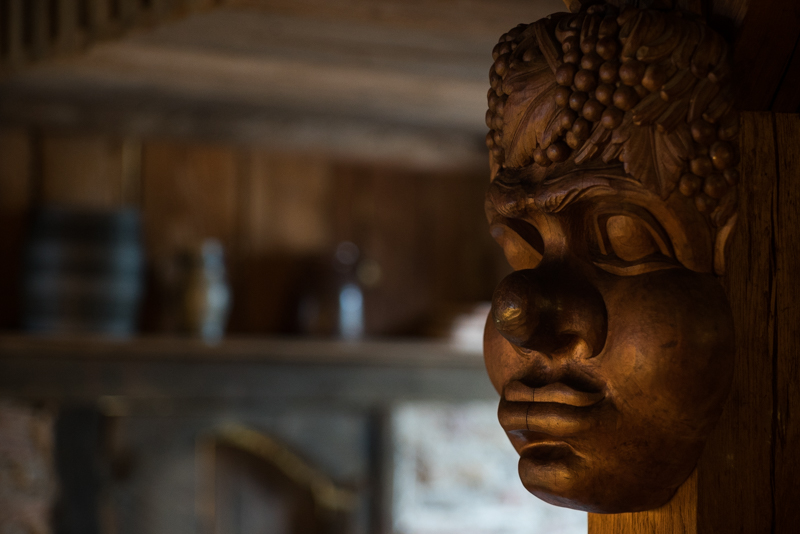
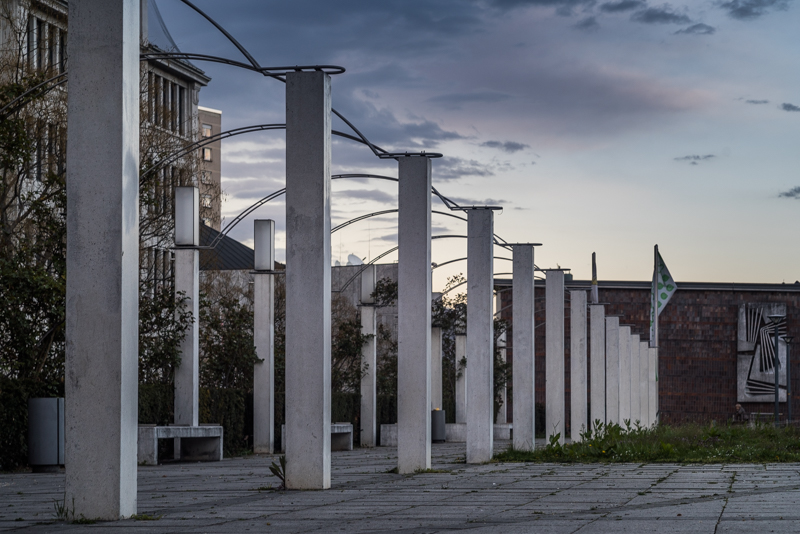
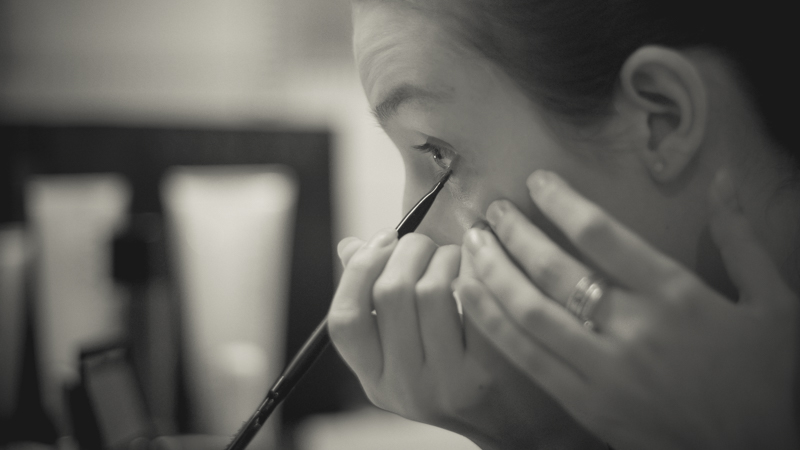
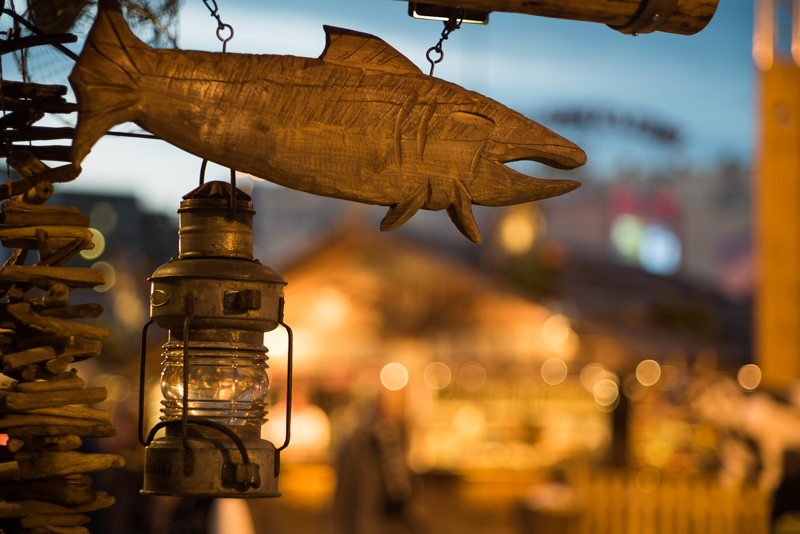
Further Reading
- Review: Contax G Zeiss 2/45 T*
- Review: Leica Summicron-M 90mm 2.0 Pre-Asph
- Review: Jupiter-3 50mm 1.5
Support Us
Did you find this article useful or just liked reading it? Treat us to a coffee!
![]()
![]()
![]() via Paypal
via Paypal
This site contains affiliate links. If you make a purchase using any of the links marked as affiliate links, I may receive a small commission at no additional cost to you. This helps support the creation of future content.
Latest posts by BastianK (see all)
- Review: Sigma 135mm 1.4 Art DG – The actual Bokeh Master - October 25, 2025
- Analogue Adventures – Part 45: Fujichrome Provia 400X (expired) - October 22, 2025
- Review: Viltrox AF 85mm 2.0 FE Evo - October 20, 2025




Great review! I bought this lens about three weeks ago and have enjoyed the unique and dreamy look that it gives to portraits and other pictures. I’m pretty sure my lens is a later edition that the one you reviewed as it is shorter, wider and matt grey. Though I currently only use cameras with APS-C sized sensors I look forward to trying this lens on a full frame camera body.
Great review! I bought this lens about three weeks ago and have enjoyed the unique and dreamy look that it gives to portraits and other pictures. I’m pretty sure my lens is a later edition that the one you reviewed as it is shorter, wider and matt grey. Though I currently only use cameras with APS-C sized sensors I look forward to trying this lens on a full frame camera body.
Clearly there are some quality differences/usage, but I’d be interested in your general thoughts on the Contax G 90mm Phillip reviewed and this lens.
Thanks!
They are quite different, yes. I was also taking a closer look at the Contax G 90mm 2.8 which seems to be a great everyday tele lens with rarely any flaws but the noisy AF and the not so great manual focus experience rather let me down.
Optically the Contax is no doubt the better lens, but you buy the Jupiter for it’s soft rendering wide open which the Contax does not have.
Luckily they are both decently priced, so you may be able to acquire both 🙂
Congratulation, great review. I have a copy from 1951 with a Zeiss block and can fully confirm your test results. I added two lens hoods, both are working very good, especially in difficult light conditions:
http://imageshack.com/a/img923/9824/SRB8UL.jpg
http://imageshack.com/a/img921/5673/o6y3iw.jpg
The second one looks like a great match to the lens!
Nice review, I enjoyed reading it. I was wondering if you had a chance to compare the M39 vs Kiev mount versions of this lens. I have the Kiev version and conventional wisdom on the net suggest Kiev version may have better coating and better performance wide open in regards to resolution and flare.
I did not yet get a chance to compare these two and haven’t yet heard about any differences either. May you have some source for this assumption?
The Kiev and 39mm thread mount versions of the J-9 have the same optics and barrel; the focus mount and aperture ring are different. You can take the barrel out of a Kiev mount lens and put it into the M39 mount, just switch the aperture ring when you do- different thickness. The KMZ manufactured lenses had better quality control than later made lenses.
Is there any difference between m42 and m39 mount performance wise ?
Great review thank you.
From what I have read so far optics seem to be identical, but I didn’t shoot them side by side.
Do you think on A6000 will have the same or better performance?
Will be pretty similar
I think as the A6000 has smaller sensor than A7, the corner flaws like softness and chromatic aberration of this lens will be less visible. You will use only the central part of the image, therefore overall performance seem to be slightly better. Also worth noting, that aps sensor uses 1,5x crop, so final image will appear to be like taken with 135mm lens.
Great review! I have got two J9, one black M42 from the 90s and one silver M39 from 1966. The black one is soft at f2 and gets sharper stopped down. The silver one is sharp wide open (on my 12MP Canon 5D) and is nice to focus. In the distance its blurry but in short distance a very good portrait lens. Here are 2 Shots between f2 and f2.8 – not sure.
https://www.flickr.com/photos/tmertens/25217697523/
https://www.flickr.com/photos/tmertens/25749200901/
Thanks for sharing these!
My Jupiter 9 is 1958 by Litkarino – bought from an Ukranian dealer and goy it fully CLA’d by a Bulgarian Lens repairman
It is in excellent condition and after reading your comment – had it fitted with a China made Leica M helicoid and a Leica LTM to M adapter
I use it for indoor close shots and find it quite effective together with my Sony A7II – thanks for sharing your expertise on this legacy glass
My Jupiter 9 is 1958 by Litkarino – bought from an Ukranian dealer and got it fully CLA’d by a Bulgarian Lens repairman
It is in excellent condition and after reading your comment – had it fitted with a China made Leica M helicoid and a Leica LTM to M adapter
I use it for indoor close shots and find it quite effective together with my Sony A7II – thanks for sharing your expertise on this legacy glass
I bought a J 9 on ebay with the Kiev mount. It has no aperture ring. Is there any way to mount it on a Sony A 7?
I don’t have first hands experience with the Kiev J9, but Kiev should be the same as M42 so a M42 -> Sony-E adapter should work.
I am quite puzzled it doesn’t feature an aperture ring though…
There is a version of this lens used for slide projectors. It doesn’t have an aperture ring.
Kiev/Contax RF mount requires a special adapter which has the aperture ring on it. Contax rangefinder cameras and their Kiev copies were made this way.
Such adapters can be found on eBay, made by Russian hobbyists. They are usually well made and work without issues.
Nope, that’s not it. Contax RF and Kiev lenses have an aperture ring, the lens this guy is referring to is a projector lens as someone else said already. I don’t know whether someone makes adaptes specifically for these lenses but I HIGHLY doubt it. There are a few sellers on eBay who make Contax RF to mirrorless adapters, and then there’s the Kipon branded ones that go for nearly 400 usd.
I want to attach a MC Ju-tier 9 to Tech art adaptor, what additional adaptor do I need?
Depends on what mount your lens has (M39/Zorki or M42/Kiev?) and what Techart adapter you are referring to (LM-EA7?).
How can I determine which mount it is?
I believe it is an m42, however.
I have thr Techart Pro Leica M mount lens to Sony e mount camera Auto Focus Adaptor.
Thank u
If it is short like this -> M42 -> you need this adapter
If it is longer like this -> M39 -> you need this adapter
Awesome Review!! I just got the JUPITER-9 85MM F2 KIEV MOUNT RUSSIAN LENS 4/3’S the adapter for the Sony a7II would be the same as the M39? Because the lens is longer like the m39
Kiev should be equal to M42, not M39.
But the M42 version of this lens should be shorter, not longer.
I believe the Kiev(Contax) mount Jupiter 9 should have the same build like M39(LTM) version. Of course not speaking about the bayonet. But both of them have shorter flange focal distance than M42 SLR version. You can see example picture of the Jupiter-9 on Kiev camera here in this link:
https://www.pentaxforums.com/forums/10-pentax-slr-lens-discussion/266755-would-leica-bayonet-fit-my-k-mount.html
Thanks for the replay Bastian! so this adapter should work?
https://www.bhphotovideo.com/bnh/controller/home?A=details&O=&Q=&ap=y&c3api=1876%2C%7Bcreative%7D%2C%7Bkeyword%7D&gclid=EAIaIQobChMIk6zBquSF2AIVTiSBCh3kugoHEAQYASABEgIe8PD_BwE&is=REG&m=Y&sku=1150784
The adapter in your link is for M42 version. Not for Kiev rnagefinder lens.
You probably need this adapter:
https://www.amazon.com/Fotasy-Contax-Rangerfinder-Bayonet-Adapter/dp/B004UPHX8S
If you have Kiev/Contax mount lens. Which looks like this:
https://www.ebay.co.uk/itm/Jupiter-9-Lens-85mm-f2-For-Contax-Kiev-Rangefinder-RF-Mount/202130596774?hash=item2f0fec23a6:g:4scAAOSw4vFZ-GUP
Can be also in black however.
There is also another different Kiev mount.
It is Kiev 10/15 camera, for which Jupiter-9 was also in production. The lens looks like this one:
https://www.ebay.co.uk/itm/JUPITER-9-automat-85-mm-f2-per-Kiev-10-15-passo-baionetta/122822356537?hash=item1c98c86e39:g:KN8AAOSwbYZXcoEN
From your description it is not clear which Kiev mount lens you own but from links above you should find what adapter you need.
Yeah, it’s like the first one just a bit longer so, the Fotasy Nikon S / Contax RF Rangerfinder to Sony E-mount should work!
Appreciate the help!
Hi everybody
I m interested by jupiter 9 MOUNT for my SONY A 7R
I have adaptateur vm voigtländer ; Is it good to adapt a jupiter 9 85/2 MOUNT supposed M39 whith VM VOIGTLANDER as I can see in your revue
Think you very much and have a good day
Michel
You will need an additional adapter from M39 screw mount -> Leica-M mount.
You can see it in this article.
Thank for the review. I just got my copy and it’s in excellent condition, as far as the aperture and focus ring; however, I’m very disappointed with the image. No matter what I do, I can’t seem to get anything in focus. My Sony a6000 has focus peaking and it does not show with this lenses because nothing is ever on focus. Is this a bad copy or am I doing something wrong. Your images seem sharp enough to me, but I can’t get that sharpness out of my copy.
There must be something wrong with your copy.
You will often find very short ones on ebay which state being “M39” (and usually these are dirt cheap) but they only work on some kind of old SLRs without an additional tube.
You mind posting a picture of your lens?
Hello Bastian,
Could you please tell me which one you think is better for portraits between the one you talked here about and the TOKINA AT-X MACRO 90MM 1:2.5?
I have too little experience with that Tokina Macro to give you a qualified answer here, sorry!
Bastian,
I have some doubts, which one is better between the M42 and M39 mount? I saw some samples that Thorsten published in the forum, but it was not clear which one belongs to M42 and which one belongs to M39. Another doubt: Is this lens good for weddings and any kind of people portraits? If not, do you have another recommendation?
Optically M42 and M39 should be the same, I prefer M39 because of the smaller size.
First 2 digits of the serial number are the production year, I would prefer a newer one, but opinions vary.
I don’t shoot weddings for free and I intend to offer my customers the best possible result so I would not use it as my primary lens.
I might use it for some additional shots with that special look though.
Then Bastian, is it possible to have a good portraits kit with the lenses mentioned here? If so, could you please recommend me that kit?
Thank you very much.
There are many portrait lenses reviewed here, how could I possibly know which one works best for you?
For weddings I have mostly been using the Canon EF 135mm 2.0 L with Sigma MC-11 adapter and now the Sony FE 85mm 1.4 GM and in addition to that a fast 35mm lens (my preference is Voigtlander VM 35mm 1.7).
But there are also people who prefer 2.8/24-70 + 2.8/70-200.
Hi Bastian,
About the Juniper mentioned here, could you please tell me if the older copies are better than the newer ones?
If I get the M39, which one can I buy among the following descriptions? (I am a little confused, I am planning to buy a A7 or A7ii)
-Zenit-type SLR
-KMZ for SRL
-Leika/Zorki rangefinder
-Leika screw mount
-Zorki FED
What about if I get the M42?
-Zenit-type SLR
-SLR
I think that the before two descriptions related to M42 are the same.
I have another doubt. The M42 is heavier, but smaller than the M39, so how can they have the same behavior?
I cannot tell you whether the older or the newer ones are better.
Apparently some of the first ones (dating back to like 195x) are still using Zeiss glass from Germany,
but I am not sure that actually means anything. I would rather try to get a newer (black one).
The casing is a bit more durable and they less likely suffer from any defects.
You are looking for Leica/Zorki/Screwmount. Kiev/Zenit SLR should be M42.
The rear barrel of the M39 is empty and made from aluminium, what the M42 ones are made from I don’t know, but they are wider.
I also recommend to check out the link in the review describing the
M39 versions: http://www.sovietcams.com/index.php?-229548952 and the
M42 versions: http://www.sovietcams.com/index.php?-1898658725
You will see that optical design is exactly the same.
Usually the sellers on ebay put up pictures, so it should be easy to spot an M39 one.
Quick question…if I buy this lens to use on a Sony A6500 crop sensor is it still 85mm or is this lens for a full frame making it around 135mm or so on a crop sensor?
All 85mm lenses when mounted on an APS-C camera are the same.
An 85mm lens on APS-C will give the same field of view as a 135mm lens on full frame.
Wow, Bastian. Your tests turned out very poorly but the sample images are gorgeous. Don’t know what to think about this strange lens.
That is true for some portrait lenses imho.
The Mitakon 50mm 0.95 would be another example 🙂
Thank you very much for this review! I’ve been exploring your website for long time, and having A7III and 55/1.8 ZA, I was interested in MF lens, but not willing to spend a fortune for “just a toy”. The same goes for 85mm FL.
After reading your review I decided to get the Jupiter-9, which is quite commonly offered here in Russia. It’s manual, inexpensive and vintage (unlike low-end Chinese MF lenses), so all boxes are checked.
After trying 3 copies, I bought a silver M39 model, produced in 1956, in near excellent condition. The first shots made me love this lens. Interestingly, it was quite easy to nail a focus on eyes even with unsteady subjects, using the “low” focus peaking — as soon as a flare in the pupil turns red from white, shoot!
https://photos.app.goo.gl/z84KUUcgqWzauwkW9
Glad you like it 🙂
Being based in Russia I am sure it is much easier to get a decent copy!
That’s right, I was able to test as much as 6 samples of the same lens in my city. The first one had had a horrible resolution in one corner.
BTW, here’s an extract from genuine Jupiter lens manual, dated back to 1970s (translated by myself):
«Note. The optical elements of modern high-quality lenses are made of special optical glass. During its production usually it’s impossible to avoid the appearance of gas bubbles. Such bubbles don’t affect the lens quality. Besides, the State Standards allow the following minor defects on optical surfaces: scratches up to 0.02 mm in width, with combined length no more than 2 light diameters, up to 5 dots with diameter up to 0.3 mm, up to 2 dust particles with size up to 3 mm, not affecting the quality. Therefore the factory doesn’t accept the RMA claims regarding the air bubbles and minor defects on glass surfaces.»
Nice pix, Vladimir! If you don’t mind me asking, what was the going price for the version that you bought (KMZ-made) and if it’s still the same today? I have some friends based in Ukraine and am trying to decide if the price difference would justify purchasing it through them as opposed to eBay.
Ciao ho un obiettivo Jupiter 9 85 mm attacco M42 matricola 9105449 presumo quindi anno “91” … volevo usarlo perchè è in perfette condizioni, non so se fa buone foto o meno ma avevo pensato di acquistare un’altra fotocamera orientandomi su un modello Pentax K20/30 ecoomico … perchè ha un tiraggio uguale M42 … ma ho letto recensioni che dicono che questa lente potrebbe avere problemi con il modello di fotocamera sopracitato dovute all’adattatore abbinato .
Potresti dirmi cosa ne pensi … se scelgo Pentax perdo qualcosa negli scatti ??? sono alla ricerca di una fotocamera non costosa perchè ho già una fotocamera 😉 che non abbia problemi che non mi faccia perdere molto utilizzando obiettivi vintage aventi attacco M42 … saluti qualsiasi info è gradita
None of us is using Pentax cameras and we would also not recommend to buy one if your primary focus is on manual lenses.
Every mirrorless with an EVF will do better, no matter whether it is Sony or Fuji.
JUPITER-9 85MM 2.0 you describe about this lance. Description was perfect.
Hi Bastian,
I have the same lens with serial no. starting with. 58, I am having issues with focusing at infinity. I have used both M39->Canon EF , M39->M42->Canon EF mount, and M39->M42->Sony EF mount. I still can’t get it to work with infinity focus. I see you have used here M39->Leica M mount -> VM-E Close focus. does this solve the problem?
You probably have the M39 SLR version instead of the M39 rangefinder version.
Is your lens shorter than the one shown here?
If so you need a long adapter as shown here.
Buen estudio comparativo de los pro y contra de este objetivo, hace años me compré uno y, efectivamente, es insuperable en el bokeh.
Besides portraiture, the Jupiter 9 is relatively popular for its niche use as an anamorphic taking lens. In this role you actually don’t want a lot of flare control as it interferes with anamorphic flare in the pipeline. The 85mm focal length is also good as the wide aspect ratio of anamorphic shots tends to vignette with shorter focal lengths and full-frame sensors.
Thanks for the review! It was decisive in my purchase of this lens.
Just got it. Serial starts with 60, but it is an m42 mount, or at least my m42 to sony e adapter works well.
Not a fan of build quality, but bokeh is delicious. Next time I’ll definitely avoid soviet “quality” and get something like schneider-kreuzhach rollei xenon 50F1.8 but for 85+mm.